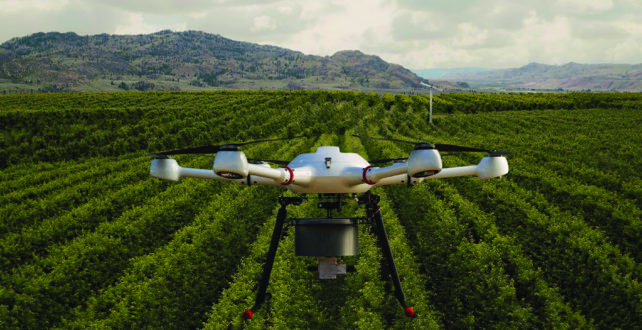

Mar 7, 2019Sterile insect releases by drone could target pest control
Researchers in Washington state and Michigan are releasing sterile codling moths by drone as a new technique for keeping “worms” out of apples.
Sterile insect releases have for some time been used as an effort for eradicating or controlling invasive species.
Sterile codling moths have been released from hoppers attached to four-wheelers in British Columbia as part of a longstanding effort to wipe that species out from the Okanagan Valley. With many sterile moths in the area, fertile wild male and female moths are less likely to mate with each other.
In its caterpillar stage, the codling moth is a common “worm” in apples or pears. Adult moths don’t directly damage fruit, but codling moth will go through multiple generations during the growing season in most apple-growing regions.
While eradicating codling moths from the Okanagan Valley has been elusive, the apple industry is now turning to the practice as a means of pest control. Cheaper and better drone technology has enabled more options for distributing the bugs. British Columbia’s existing facility for rearing sterile codling moths is a ready asset for the project.


An opportunity
“We see this as really a great opportunity to kind of marry technology with this moth-rearing facility and put together a really effective tool for the Michigan growers,” said Christopher G. Adams, a post-doctorate researcher in the Michigan State University Department of Entomology. “A few growers have already approached us and want to work with us, so we’re pretty excited.”
Adams spoke at the recent Great Lakes Fruit, Vegetable and Farm Market EXPO in Grand Rapids, Michigan, about the work in British Columbia, and his own research on using the bugs.
“Eradication didn’t quite make it, but for control they’re doing a bang-up job,” he said. Wild populations of the moths were reduced by 94 percent. “It’s a great tool for control of a key pest.”
Location matters
Adams said the Okanagan-Kootenay Sterile Insect Release (SIR) Program has the world’s only facility for rearing sterile codling moths. Moths are irradiated at the facility, rendering them infertile, although they still fly and behave normally, Adams said. SIR’s facility in Osoyoos, British Columbia, produces approximately 1.5 million sterilized moths per day, according to the program’s website. SIR releases about 135 million sterilized moths each summer in orchards from Osoyoos to Salmon Arm.
The facility in the past has shipped small numbers of the moths to researchers in the U.S., South Africa, New Zeeland and Europe. Currently, the moths are driven across the national border to Washington and then shipped overnight to Michigan. Adams said the company he’s working for, the M3 Consulting Group, is asking for a larger amount of codling moths for distribution in the U.S., and he is hoping to use some of those moths for tests in Michigan. Adams and other U.S. researchers also hope to get the sterile insects classified as farm-reared, so U.S. authorities don’t have to search every package of them that is driven across the border.
Long-term, if moth releases are effective, it might make sense to establish rearing facilities in the U.S., Adams said.
Efficiencies of dispersal
Ahead of U.S. research results, some organic growers in Washington are already interested in having the M3 Consulting Group do insect releases, based on the demonstrated success in Canada, Adams said.
But Adams envisions a release program much different than Canada’s, where millions of sterilized moths are released each year by four-wheelers that drive through orchard rows in the Okanagan Valley. Drone dispersal could be more efficient.
“The drone flies over a 40-acre block in under five minutes, so it can release thousands of moths in just a few minutes,” he said. Adams, who wrote his doctorate thesis on how codling moth populations move, believes “moths will do most of the work for us.”
“They’ll distribute themselves,” he said.
He said the Canadian program was originally aimed at eradicating the moths, and simply controlling the populations by releasing sterile moths in hotspots, or “center point releases,” might not take the many millions of moths with which the Canadians are blanketing the Okanagan.
“We were thinking if we can figure out how to make it as effective and same cost as a pesticide, then growers could rotate in a few weeks of sterile insect release in place of that control spray that they would use maybe first generation or second generation,” Adams said. “What that would allow growers to do is spray pesticides less frequently, but still get good control.”
Even conventional growers with little interest in integrated pest management might see a value in sterile insect release, Adams said. Maximum residue limits are a challenge of pesticide use and of course, pests may eventually become resistant to particular chemistries.
“Insects all over the world, in every cropping system, have developed insecticide resistance over time,” he said.
– Stephen Kloosterman, FGN Associate Editor
Above: Drones can be used for remote releases of sterile insects. Photos: M3 Consulting Group














